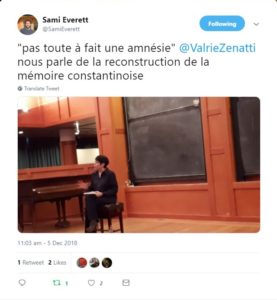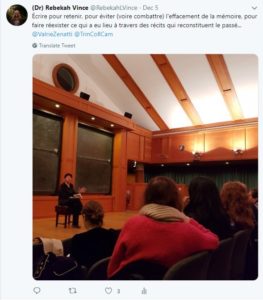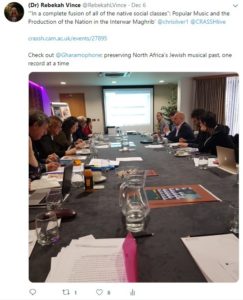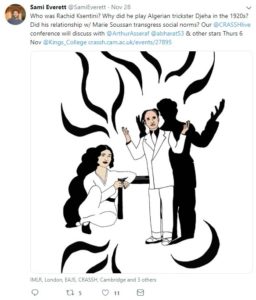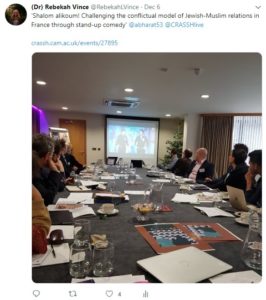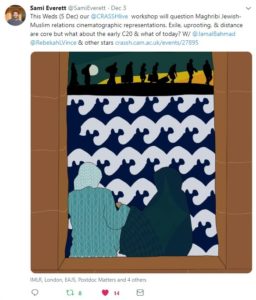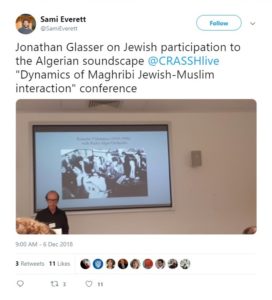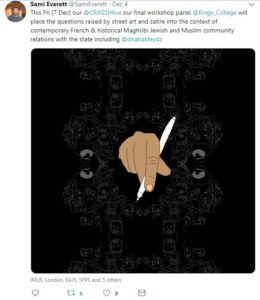Rebekah Vince (Warwick) and Sami Everett (Cambridge) report on the conference Dynamic Maghribi Jewish-Muslim Interaction across the Performing Arts, held at the Centre for Research in the Arts, Humanities and Social Sciences, University of Cambridge on 5-7 December 2018.
This conference brought together a research network of early career and more senior scholars researching and producing artistic representations across the genres of music, theatre, film, comedy, and art, to discuss how these relate to Maghribi Jewish-Muslim interaction, collaboration, and dialogue from 1920 to the present day. Emphasis was placed on artistic cooperation, intergenerational transmission, creative representation and dynamic interaction between Jews and Muslims on both sides of the Mediterranean. By discussing these themes, the conference challenged polarised narratives surrounding Jewish-Muslim relations in the Maghrib and France which tend to focus either on anti-Semitism and Islamophobia or on nostalgia and utopianism.
Through this bilingual and interdisciplinary conference, we established a network of scholars from France, Morocco, the UK, the US and Canada, including participants from the social sciences, history, literature, anthropology, music, and modern languages. The presentations and ensuing discussions interrogated moments of rupture as well as continuity in Maghribi Jewish-Muslim interaction, the significance of subterranean cultural work of mediation and transmission surrounding memories of Jewish life in the Maghrib, and the potential of performative artwork to challenge stereotypes and offer dialogic alternatives to polarised approaches.
Threads included:
• Multilingualism (localised variants of Arabics in Maghrib/Mashriq and Judeo-Arabic, question of accent, French, Hebrew, Yiddish), translation
• The role of humour in depicting Muslim-Jewish interactions and satire as catharsis
• Absence/presence of Jews in the Maghrib as manifested in performance art
• Influence, aesthetics, and performance relating to Jewish-Muslim interactions
• Memory and amnesia of Jewish life in the Maghrib as depicted in (or left out of) performative artwork
• Challenging stereotypes and assumptions through performative collaboration
Questions that emerged included:
• How to look at the specificities of cultural interactions within temporal and geographical context
• How to talk about the Maghrib in relation to Israel/Palestine without diminishing the importance of local interactions historically and in the present day
Conference Overview
Keynote 1: Valérie Zenatti (independent author), ‘La mémoire trouée [Perforated Memory]’
The conference began with an autobiographical keynote in French by Valérie Zenatti, author, screenwriter, and translator of the late Aharon Appelfeld (from Hebrew into French). Born to Algerian and Tunisian Jewish parents, Valérie Zenatti grew up in France where her encounter with the Holocaust was mediated through the American television series Holocaust (1975) and later through the writings of Ukrainian-Israeli writer Aharon Appelfeld, whose translator she was to become. Her affiliative relationship with Aharon Appelfeld is recounted in her (auto)biographical novella Mensonges [Lies] (2011) which preceded her prize-winning novel Jacob, Jacob (2015), an exploration of Jewish life in Algeria during the Second World War and decolonisation. Both these texts, alongside Une bouteille à la mer de Gaza [A Bottle in the Gaza Sea] (2005) and its film adaptation, featured in her conversational keynote, which addressed issues of memory and forgetting, filiation and affiliation, erasure and reconstitution. Questions and ensuing discussion revolved around the (im)possibility of return, the absence of Muslims in some accounts of Jewish life in the Maghrib, and dialogic approaches to the Israeli-Palestinian conflict. Watch the trailer to Une bouteille à la mer de Gaza [A Bottle in the Gaza Sea] (2005).
Session 1: Popular Music
Chaired by Ruth Davis, University of Cambridge, this session explored Jewish-Muslim dynamic interaction in Maghribi popular music, from concert halls in the interwar Maghrib (Chris Silver, McGill University) to narratives of peaceful religious coexistence in Moroccan patriotic rap (Cristina Moreno Almeida, King’s College London). Listen to Casa Mdinti – V-mic featuring Bizz-tourisque (2006).
These presentations prompted discussion around the construction of the nation and engaging in politics with a capital or lower-case “p”.
Session 2: Staging and Performance
Chaired by Arthur Asseraf, University of Cambridge, this session included a presentation by Mourad Yelles, INALCO, on theatre as meeting point between Algerian Jews and Muslims with a particular focus on the Jewish actress Marie Soussan. Listen to Marcha Djazairia.
This led to a discussion on similar values among Jewish and Muslim families, and a shift in focus from a socio-cultural analysis to a political and aesthetic one. The session also included a presentation by Adi Bharat, University of Manchester, on how the conflictual model of Jewish-Muslim relations in France is challenged through stand-up comedy, taking the comedy duo Younes and Bambi (‘l’Arabe et le Juif’ [the Arab and the Jew]). This raised questions about exaggeration to the point of ridicule and reinforced the general consensus at the conference that interactions is a more useful concept than relations when speaking about Jewish-Muslim performance art in terms of influence and collaboration.
Session 3: Cinematic Representation
Chaired by Rebekah Vince, University of Warwick, the discussion in this session revolved around cinematic, musical, and linguistic depictions of Jewish-Muslim relations in both Morocco and Israel. Presentations were given by Miléna Kartowski-Aïach, Idemec/Université d’Aix Marseille, on forbidden memory and political song in Kamal Hachkar’s mediatory films, and by Chana Morgenstern, University of Cambridge, on decolonising Hebrew through Arabic in the film adaptation of Almog Behar’s prize-winning short story “I’m one of the Jews”. This led to a debate on whether or not Palestine/Israel can ever be excluded when speaking about Maghribi Jews in the contemporary moment, even in analysing Jewish-Muslim interactions in North Africa before the foundation of the State of Israel.
Keynote 2: Jonathan Glasser, Associate Professor of Anthropology, William & Mary, ‘Maghrebi-Jewish Musical Intimacy’
This keynote began with an analysis of how music seems to challenge discourses of antagonism that emphasise Muslim-Jewish conflict and posit Jews as pariahs in North African society. Yet a closer look revealed that Muslim-Jewish interactions music and surrounding debates were nevertheless marked by tropes of rivalry, marginality, and ambivalence. Jonathan Glasser focused on the case of Algeria to account for the centripetal forces of these tropes and to provide a rich alternative for understanding Muslim-Jewish dynamic interactions in the Maghrib and its diaspora.
Session 4: Comedy and Satire
Chaired by Warda Hadjab, EHESS, this session looked at absent depictions of Jewish heritage and Muslim-Jewish relations in Algerian caricatures and graphic novels from 1967 through the 1980s (Elizabeth Perego, Shepherd University), and creative co-existence in the work of street artist “Combo” (Nadia Kiwan, University of Aberdeen). These presentations were a springboard into discussion about whether we are dealing with total rupture or lingering traces when addressing the immediate post-independence period: Chris Silver suggested we might talk about ruptured continuity. We also addressed the question of gender (“Is street art male?”) and the extent to which displaying religious symbols in public space acts as a provocation in secular France. Continuing with concepts of satire and comedy, we considered how malaise is dealt with via the medium of humour, how assumptions are deconstructions, and how anti-Semitism and Islamophobia are challenged through performative artwork.
In the concluding comments, the question was again raised, this time by Arthur Asseraf, University of Cambridge, as to the breakdown, rupture, and absence of the immediate post-independence moment. Often when looking for interactions, our attention is drawn to the interwar period or more recent examples. Chris Silver suggested that there was a possibly nostalgic need to fill the absence. The Christian question was also raised: Christians are often depicted as the dominant power yet, in the Arab world at least, Christians have a distinctive (minority) identity. Seth Anziska, UCL, noticed how the conference was working against the lachrymose view of history and this led to a discussion on whether or not we were engaging in “grieving cosmopolitanism” and the potential (creative or otherwise) of this concept, which need not be a negative one. Jonathan Glasser suggested that co-resistance was a useful way of looking at performative collaboration and co-creative artwork. Vanessa Paloma Elbaz, University of Cambridge, brought up the myth of “the last Jew” and the phenomenon of contemporary Muslims self-identifying with a suppressed past, notably in relation to Judeo-Berber identity within the Arabo-Muslim context of the Maghrib. Miléna Kartowski-Aïach spoke of the subterranean work and the role of mediators in the transmission of cultural memory, which is beginning to bear fruit in changing perceptions and opening a space for interfaith dialogue.
Co-conveners: Dr Sami Everett (University of Cambridge), Dr Arthur Asseraf (University of Cambridge), Dr Rebekah Vince (University of Warwick)
Sami Everett, University of Cambridge, and Rebekah Vince, University of Warwick, are co-editing a volume on Dynamic Maghribi Jewish-Muslim Interaction across the Performing Arts commissioned by Liverpool University Press for publication in their Francophone Postcolonial Studies series in 2020.
Supported by the Centre for Research in the Arts, Social Sciences and Humanities (CRASSH), the European Association for Jewish Studies (EAJS), the Institute of Modern Languages Research, Université PSL, and the University of Cambridge’s Faculty of History.
.

